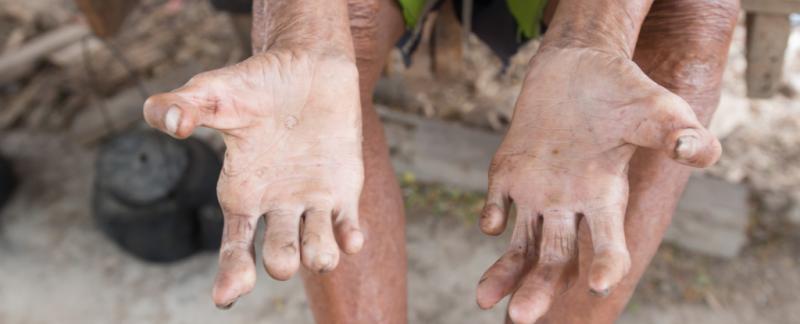Leprosy Appears to Be on The Rise in Florida
By: ByCLARE WATSON

Leprosy Appears to Be on The Rise in Florida

A man suffering from leprosy shows his hands. (frank600/iStock/Getty Images Plus)
A 54-year-old Florida man diagnosed with leprosy adds to a growing number of cases detected in the south-eastern United States, which appears to be a new hotspot for the disease.
It follows recent alerts from the US Centers for Disease Control and Prevention (CDC) of the first cases of locally-acquired malaria in the US in two decades; four of which were in Florida.
Leprosy incidence, or rates of new leprosy cases, has been increasing in southern parts of the US since 2000, with reported cases more than doubling in south-eastern states over the past decade. Central Florida now accounts for almost one-fifth of US cases.
Yet a shrinking proportion of US leprosy cases are diagnosed in people born outside the country, while a growing number of reported cases appear to lack any of the typical risk factors of the disease.
"Those trends," write the three dermatologists who alerted public health officials to the Florida man's diagnosis, "contribute to rising evidence that leprosy has become endemic in the south-eastern United States."
Leprosy, also known as Hansen's disease, is a bacterial infection caused by Mycobacterium leprae and the more recently discovered M. lepromatosis . It is a curable yet neglected tropical disease, which still occurs in more than 120 countries.
About 150 cases of leprosy are reported in the US each year. Unique strains of M. leprae have been detected in US patients , though most cases are people who have traveled from countries where leprosy is present or endemic.
Other risk factors include exposure to animals such as nine-banded armadillos, which are known to harbor M. leprae , and prolonged, close contact over months with someone who has untreated leprosy, which is spread via droplets from the nose and mouth.
But the 54-year-old man, a lifelong Florida resident, told contact tracers he had not been traveling, nor come into contact with someone known to have leprosy or any armadillos. He works as a landscaper though, spending much time outdoors.
The man presented to a dermatology clinic with a painful rash and skin lesions that first appeared on his feet and arms, but then progressed to his trunk and face.
Biopsies confirmed a diagnosis of leprosy, and public health officials were alerted, according to national protocols.
The man's case, like roughly one-third of new leprosy cases diagnosed in the US between 2015 and 2020, appears to have been locally acquired.
"Our case adds to the growing body of literature suggesting that central Florida represents an endemic location for leprosy," dermatologists Aashni Bhukhan, Charles Dunn, and Rajiv Nathoo write in their case report.
"By increasing local physician efforts to report incidence and supporting further research to assess routes of transmission, a congruent effort can be made to identify and reduce spread of the disease."
In particular, the absence of known risk factors in this and other recent cases of leprosy in Florida, in people spending time outdoors, has researchers wanting to investigate possible environmental reservoirs of the bacterial disease.
"The transmission of this disease is probably much more complicated than was thought before," write the authors of a recent systematic review, which analyzed global leprosy transmission data published between 1945 and 2019.
It supports an increasing role of anthroponotic (human-to-human) and zoonotic (animal-to-human) transmission of leprosy.
The second known causative agent of leprosy, M. lepromatosis , was only identified in 2008 , 150 years after the disease was first attributed to M. leprae.
Researchers are trying to understand the prevalence of M. lepromatosis infections and from which animals it spills over into humans.
"It is perhaps remarkable that a new [bacterial] species causing an endemic disease of major public health impact has not prompted larger-scale studies to determine its true prevalence," researchers remark .
The Florida case report has been published in Emerging Infectious Diseases .
The administrator of this group reserves the right, along with the site moderators, to moderate all and any postings to this group, including the right to enforce the ToS, the CoC, and also including anything that the administrator deems within his sole discretion to be offensive, including and not limited to off topic comments, with the power to delete in exercising those rights.
It would be best, therefore, to be civil in posting on this group.
By now it should be well known that I am unable to open certain sources, videos and pictures. If I cannot, I will ask that they be described and explained. If the poster refuses to comply, their comment will be deleted. Instagrams are banned.






WARNING TO FLORIDA NT MEMBERS: Jesus isn't going to send a cleansing rain for you as He did in the movie Ben Hur.